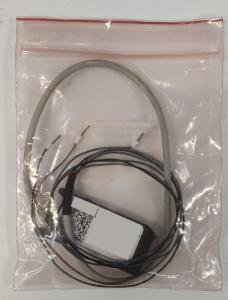Fiber optic sensors play a crucial role in various industrial fields thanks to their ability to offer precise and reliable measurements. In this article, we'll explore what exactly a fiber optic sensor is, how they work, and why you should consider choosing kheeos for your fiber optic sensor needs, and for your general sensor needs.
What is a fiber optic sensor?
A fiber optic sensor is a technology that uses optical fibers to measure different physical parameters such as temperature, pressure or even mechanical deformations. Its particularity lies in the use of light guided by the fiber to obtain information about the environment or about objects of interest.
Basic principles
Optical fibers are very thin wires usually made of glass or plastic capable of conducting light by total internal reflection. This waveguide principle allows light to travel long distances with very little signal loss. When it comes to sensors, these fibers can detect environmental changes by analyzing variations in light reflection.
Various applications
Thanks to their great versatility, fiber optic sensors are used in various applications such as the oil industry, environmental monitoring, and even the medical sector. Their ability to provide discrete and precise measurements even in extreme conditions makes them a preferred choice for many engineers and scientists.
How does a fiber optic sensor work?
The operation of a fiber optic sensor is mainly based on the interaction between light and the surrounding material of the fiber. This interaction can affect different aspects of light, such as its intensity, its phase or even its polarization.
Sensor geometry
The design of a fiber optic sensor often depends on how the fiber is structured and oriented. The geometry of the fiber greatly influences the way it responds to external stimulation, allowing extremely precise measurements. For example, Bragg gratings in optical fibers modify the wavelength of reflected light depending on mechanical or thermal stresses applied to the fiber.
Changes in light intensity
One of the common methods for collecting data through a fiber optic sensor is to monitor variations in light intensity propagated through the fiber. Any alteration in this intensity may indicate a change in the conditions surrounding the fiber. These sensors are particularly useful for tasks such as measuring pressure or small movements.
Telecommunications and simultaneous capture
In addition to their use in detecting physical parameters, fiber optic sensors also play a key role in telecommunications. By their nature, they enable the rapid and efficient transmission of large amounts of data while simultaneously performing precise measurements. This unique combination gives optical fibers a significant advantage in complex configurations requiring both sensing and communication.
Why choose kheeos for the purchase of your fiber optic sensors?
kheeos stands out as one of the market leaders in fiber optic sensors. The products offered by kheeos combine technological innovation and reliability, making your choice obvious for various essential reasons.
Expertise and innovation
kheeos has extensive experience in the field of optical fibers, accumulated over the years. This expertise allows Kheeos to offer innovative solutions suitable for a variety of industrial applications. Whether for precise temperature measurements in hostile environments or for detecting small movements in mechanical structures, Kheeos sensors will meet your most stringent requirements.
Quality and robustness
The products supplied by kheeos are renowned for their durability and sturdiness. Each fiber optic sensor is thoroughly tested to ensure *optimal* performance under the most demanding conditions. This ensures stable and precise detection, thus minimizing the risk of error or malfunction.
Technical support and personalized advice
Choosing kheeos also means benefiting from exceptional technical support and personalized advice. Kheeos' committed customer service is always available to help resolve technical issues and provide recommendations tailored to your specific needs. This approach ensures that you get the best return on investment for every purchase.
Customization and flexibility of solutions
Finally, kheeos offers exceptional flexibility in the customization of its fiber optic sensors. Whether you need specific adaptations for your projects or want to integrate additional technologies, Kheeos can adjust its offerings according to your particular requests. This makes Kheeos the ideal partner for ambitious projects requiring tailor-made solutions.
Keywords and essential concepts
To fully understand and optimize the use of fiber optic sensors, several keywords and concepts are particularly important. Among these are the notion of waveguide, which characterizes the mode of propagation of light in a fiber, and the geometry of the sensor, which plays a major role in its sensitivity and precision. A thorough understanding of these principles helps improve practical applications and increase the efficiency of systems using optical fibers.
Other terms such as light intensity and stable detection are also of particular importance. Light intensity, for example, often serves as the primary variable in optical sensors, while the notion of stable sensing indicates the reliability and consistency of measurements made by these advanced technologies.
In summary, fiber optic sensors combine unique advantages such as high precision, the ability to operate in harsh environments, and the possibility of simultaneous data transmission. Choosing kheeos for your fiber optic sensors and also for other sensors guarantees not only superior quality products but also reliable technical support tailored specifically to your needs. Therefore, investing in fiber optic sensors from kheeos constitutes a strategic decision to obtain exceptional results in all your industrial and scientific projects.















